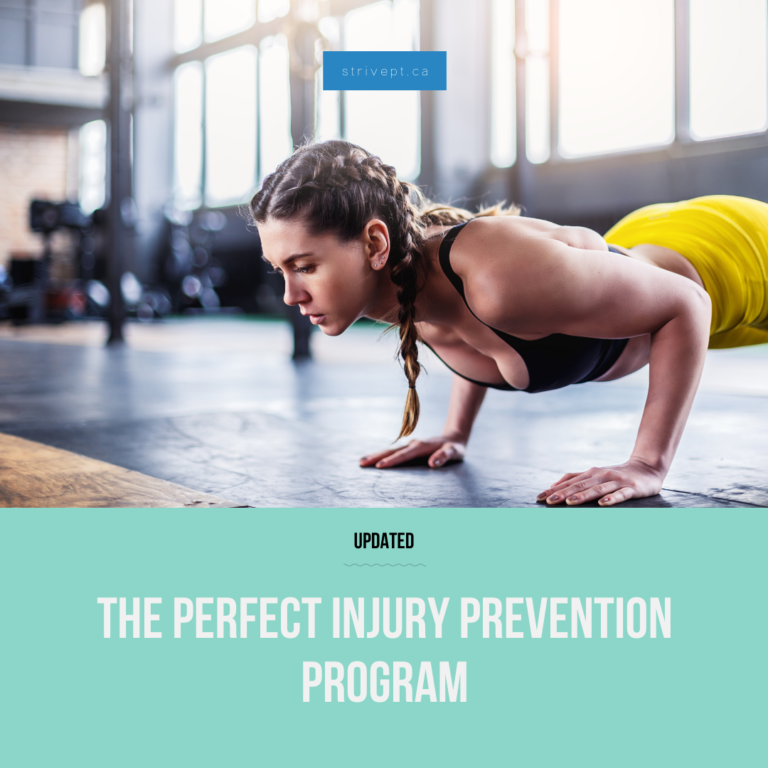
Are you an athlete? Is your child an athlete?
Are you more of a weekend warrior just trying to stay healthy? Whatever your situation, it’s likely you’ve thought about injuries. Whether you’ve had an injury, know someone who’s had an injury, or just don’t want to ever get an injury, the thought of “injury” has certainly crossed your mind.
With that, hopefully this comes to mind: Injury Prevention.
This blog post will cover just that. You will learn about the perfect injury prevention program, and it may not be what you think it is.
Before we delve too much into the ‘ins-and-outs’ of injury prevention, it is important to understand who the injury prevention is for.
How old is the person, and how old is the person?
(That’s not a type-o). Chronological Age vs. Biological Age vs. Training Age Typically, these age definitions are more applicable to children/adolescents/teenagers (which will make sense shortly), but can apply somewhat to adults (which I will touch on later).
For now, a clarification on each definition.
Chronological age:
How many years and months old is Person A (let’s call him Mike). Mike was born in January 2006.
Today is June 2018. Therefore, Mike is 12 years old. More specifically, Mike is 12 years and 5 months. Therefore, he will play Under-13 hockey.
As many of us have seen, not all Under-13 hockey players are physically the same. Read on.
Biological age:
This is far more complicated, and probably warrants its own blog post. In short, you need to calculate the maturity offset of the individual (i.e. predicted years from their peak height velocity).
(Peak height velocity is the period of time in which a child experiences their fastest upward growth in their height – i.e. the time when they grow the fastest during their adolescent growth spurt).
On average, this happens in females at age 11, and in males at age 13.
In adolescents, you can calculate this with anthropometric measurements (i.e. age, height, etc.).
Calculating this in adults is much more complicated.
If you are interested in reading more about this, check out Klemera & Doubal’s article here, Mirwald and Baxter-Jones here, and Ford et al here.
Why does this matter?
In very short, our chronological-aged Mike from earlier who hit his peak height velocity at age 10, may therefore require a different training regime than his buddy Maverick, who is still 2.3 years away from hitting his peak height velocity.
This would apply even though Maverick was also born in January 2006 (12 years, 5 months old). If you want additional clarification, check this out.
Training age: refers to the total training time (experience) the person has in their sport (or in that aspect of training – i.e. weight lifting or agility training).
Fairly straightforward definition; often overlooked in practice.
Why did I tell you this? The primary reason I chose to outline these differences is because training age and biological age (even a prediction of whether or not the adolescent has hit their peak height velocity or not), can help determine a more appropriate training focus (more so than chronological age, especially in those aged 8-18 years).
Consider 2 new made up children who are both 13 years old:
1. Charlie
- 13 years, 3 months old
- 90th percentile in both height and weight for his age (looks like he’s 16 years old already)
- Plays Under-14 soccer
- Started playing soccer at age 4, competitive soccer at age 8, and started additional agility and strength training at age 12
2. Kenny
- 13 years, 6 months old
- 10th percentile in both height and weight for his age (looks like he just turned 10 years old)
- Plays Under-14 soccer
- Started playing soccer last year, and has never played any other sports growing up
Of course, Charlie and Kenny are the extremes, but it hopefully illustrates my point that the training programmes for these two individuals will probably be quite different, even though they both play Under-14 soccer (they could even be on the same team!)
In children/adolescents: evidence suggests that preadolescents (i.e. Kenny from above) benefit most from sprint training and plyometrics (high levels of neural activation).
While adolescents (i.e. Charlie from above) benefit more from training types which target both neural and structural development (strength training and plyometrics).
In adults: it is important to consider training age when formulating an exercise program.
If you are you going to target strength changes via weight lifting, how much experience does the person have with weight lifting?
15 years of good weight lifting form, practice, and consistency? Great, you can probably try most things.
Never lifted a weight in their 35 year lifespan? Maybe start a little more basic and progress slowly.
Injury Prevention Here’s a tough pill to swallow: injury prevention might not be entirely possible (based on current evidence, anyways).
To my knowledge, the only true risk of injury is a previous injury (and maybe gender for a few types of injuries).
The risk of reinjury is usually higher when you first return to the sport and it weans with time. That’s right, with time.
Often, we don’t give ourselves enough time to heal, and that could be a big part of re-injury.
Additionally, many injuries may be considered ‘unavoidable’, or have nothing to do with the athlete/person’s inner strengths, (im)balances, and (in)abilities.
For example, you could step in a pothole while running, another player could collide with you (accidentally or on purpose), or the puck/ball could hit you in the arm/foot/head.
The Perfect Injury Prevention Program After reading the last two paragraphs, you’re probably wondering how there could be a ‘perfect’ injury prevention program.
Well, that’s just it, because there is no scientifically agreed upon, completely proven, 100% successful injury prevention program, the one I’m going to outline is as perfect as it gets 🙂 .
Disclaimer: Before we get into the next part of this blog post, it is important to note that everything in this blog post is for information purposes only. This blog post is not intended to be strict medical or exercise advice. Everyone is an individual, and therefore, individual variances do occur.
It is important to consult your physiotherapist, doctor, or exercise scientist for the most applicable advice for you.
Injury Prevention Program – General Steps to Success:
Step 0: Make Sure You’re Not Already Injured
- If you are already injured, go see your physiotherapist. Sort that out. While you’re there, and once you’ve healed up, it’s worth inquiring about the rest of the steps outlined below.
Step 1: Ensure Appropriate Mobility
- Before you can move quickly or explosively, you should first ensure that you can move properly.
- The specific movements that you need to be able to perform well will change somewhat depending on your goals/sport, but good movement skills can never be overrated. You’ll also want to be able to train the range of motion you want to use.
- Movement form is also important when translating movements into strengthening exercises. Example: Squatting. If you can’t squat well (safely, good form) without weight, I don’t recommend adding weight and trying to squat for strength. I also don’t recommend doing squat jumps for plyometric/explosive power, and I certainly don’t recommend doing it as fast as possible.
- If you don’t know what it means to ‘move well’, this is a good step to enlist professional help. Physiotherapists love meeting people who are keen on building a more resilient body. Learning what movements you do well, and which movements may require more practice will require very few appointments, and then you can rest easy knowing you have a good foundation.
Step 1: Move as well as possible! Check out this example of good squat form.
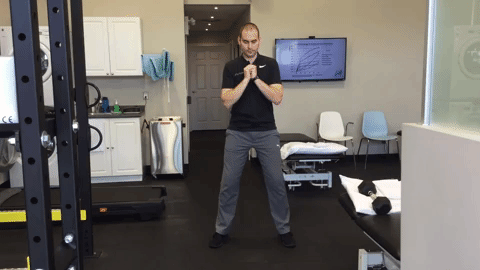
Step 2: Build Basic Strength
- Once you’ve learned how to move safely and appropriately with just your body weight, it’s time to start adding weight in order to build strength.
- Again, your primary strength focus will likely depend on your goals/sport.
- Begin building strength in all large muscle groups, while adding accessory exercises based on your personal goals.
- For example, if you’re a soccer player, try building strength in all large muscle groups with squats (legs, glutes, and core), lunges (legs and glutes), push-ups/bench press (chest, arms, and core), and rows (back).
- Then add some additional accessory movements for soccer-specific muscles: hip muscles (hip thrusters or clamshells), thigh muscles (wall sits or knee extensions), calf muscles (heel raises).
- If you want to target your specific weaknesses (but don’t know what they are), or need help learning which muscles are most important for your specific goals, enlist professional help.
- Step 2: Get as strong as possible! See this example of squatting with weight:
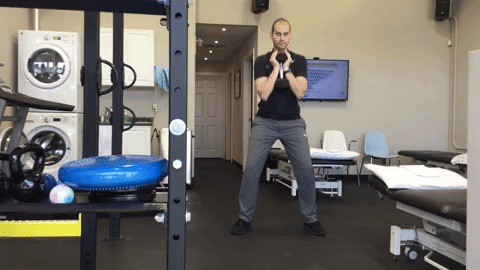
Step 3: Start to Gain Power (Learn Plyometrics)
- Dictionary definition of plyometrics: exercise involving repeated rapid stretching and contracting of muscles (as by jumping and rebounding) to increase muscle power.
- Once you have built adequate strength, it’s time to start gaining muscle power. Enter plyometric training.
- To work off the previous soccer player example: learn to safely perform repeated jumping squats (usually only up to 6-8 repetitions at a time), ensuring you continue to have good form (remember step 1). You may also try side to side bounding, or forward broad jumping for example!
- While learning plyometrics, focus more on form and repetition than pure speed. That comes in Step 4.
- This is the step where you will also focus on both take-off and landing mechanics. Learn to land softly, and teach your body to absorb the forces associated with power training.
- Step 3: Learn safe plyometrics! Here is an example of jumping with good landing mechanics:
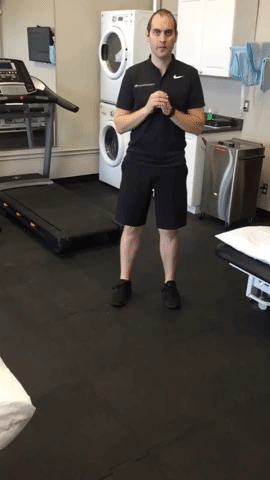
Step 4: Gain Real Power and Train Perturbations
- Once you are confident that you have adequate mobility, good strength, you’re able to complete plyometric training safely, and you have good landing mechanics, you’re ready for the final step: high-level power and control
- Speed up your plyometric training. Aim for faster, aim for higher, but never compromise control/safety.
- Mix in perturbation training. For example, explode into a jump squat, but have someone push you in mid air from an unexpected angle and still focus on good landing mechanics.
- Step 4: Perform challenging plyometrics and perturbations! See this example of a plyometric/perturbation combo exercise:
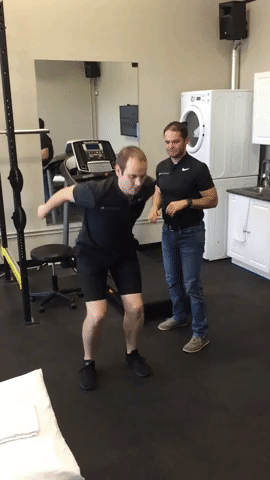
Caveat: Where you start with the above Injury Prevention Program, how much you focus at each level, and how fast you progress will depend entirely on your previous experience, ability to safely perform exercises, and your individual variances. Hopefully some of the introductory discussion of this blog post will help you decide where approximately you sit (remember biological and training age). When in doubt, progress slowly, monitor your body’s responses, and enlist the help of a professional.
Why This is the Perfect Injury Prevention Program The perfect injury prevention program is individualized. It’s based on an individual’s strengths/weaknesses, goals/ambitions, and sport/activity.
Therefore, the injury prevention program outlined above is perfect because:
- It’s general.
- It’s modifiable.
- It can be individualized.
- It outlines the areas of importance to work on to ensure good athletic ability.
Further, it is highly likely that as you work on building a resilient body, you will be blending the steps together. In general, they are a progression.
However, once you make good progress, it’s important to remember the value each step has on your overall abilities.
Just because you can complete high-level plyometric training, it certainly doesn’t mean that you should stop trying to improve mobility/control, and strength.
When we’re talking about progress, you may be thinking how quickly can I move through these steps?
When do I know how to take the next step? Can I get injured by progressing too quickly?
Recently, researchers have come up with a great way to track your progress, and to help guide your training, thus reducing injury risk.
The calculation they’ve used is called the acute to chronic workload ratio. In a nutshell, it’s used to measure the amount of exercise you’ve done over the past week compared to the past four weeks.
If there’s a large difference, you’re at a potentially higher risk of injury. A lot of this research has been based on adults.
There’s more that needs to be done for adolescents. This also warrants it’s own blog, so for further information about this ratio, check this out.
The Additional Steps to Make This Program More Perfect-er
- Don’t forget to focus on RECOVERY. Rest as needed. Give your body the time it needs to recover from the stresses you’re placing on it (remember that emotional/mental stress counts too!)
- Change training loads GRADUALLY.
- Drink lots of water.
- Eat primarily healthy meals, but spoil yourself once in a while.
- Sleep 7-9+ hours a night.
- Have fun. Involve friends/family. Enjoy some healthy competition.
- Ask for help. Seek professional support – see a nutritionist, a physiotherapist, a psychotherapist/counsellor – they can help you with the roadblocks you’re facing.
- Write things down. Write down progress. Write down goals. Have a clear plan. You can’t change what you don’t measure.
Conclusion Unfortunately, many injuries are unavoidable. That being said, building a resilient body helps prepare you for the variety of forces that could be placed upon it with sports/exercise.
Slowly, and progressively work on your athleticism. Work hard. Rest hard. Get help when you need it.
At Strive Physiotherapy and Performance, we are committed to providing an in-depth assessment to ensure we can work together to find the best plan of action for each individual client. Call us at 519-895-2020, or use our online booking tool on www.strivept.ca to book an appointment with one of our knowledgeable physiotherapists.
Take care, Tyler Allen and Mike Major Physiotherapists at Strive Physiotherapy & Performance